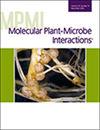求助PDF
{"title":"Transcriptomic Profiling of '<i>Candidatus</i> Liberibacter asiaticus' in Different Citrus Tissues Reveals Novel Insights into Huanglongbing Pathogenesis.","authors":"Amelia H Lovelace, Chunxia Wang, Amit Levy, Wenbo Ma","doi":"10.1094/MPMI-08-24-0102-R","DOIUrl":null,"url":null,"abstract":"<p><p>'<i>Candidatus</i> Liberibacter asiaticus' (Las) is a gram-negative bacterial pathogen associated with citrus huanglongbing (HLB) or greening disease. Las is transmitted by the Asian citrus psyllid (ACP) where it colonizes the phloem tissue, resulting in substantial economic losses to the citrus industry worldwide. Despite extensive efforts, effective management strategies against HLB remain elusive, necessitating a deeper understanding of the pathogen's biology. Las undergoes cell-to-cell movement through phloem flow and colonizes different tissues in which Las may have varying interactions with the host. Here, we investigate the transcriptomic landscape of Las in citrus seed coat vasculatures, enabling a complete gene expression profiling of Las genome and revealing unique transcriptomic patterns compared with previous studies using midrib tissues. Comparative transcriptomics between seed coat, midrib, and ACP identified specific responses and metabolic states of Las in different host tissue. Two Las virulence factors that exhibit higher expression in seed coat can suppress callose deposition. Therefore, they may contribute to unclogging sieve plate pores during Las colonization in seed coat vasculature. Furthermore, analysis of regulatory elements uncovers a potential role of LuxR-type transcription factors in regulating Liberibacter effector gene expression during plant colonization. Together, this work provides novel insights into the pathogenesis of the devastating citrus HLB. [Formula: see text] Copyright © 2025 The Author(s). This is an open access article distributed under the CC BY-NC-ND 4.0 International license.</p>","PeriodicalId":19009,"journal":{"name":"Molecular Plant-microbe Interactions","volume":" ","pages":"56-71"},"PeriodicalIF":3.4000,"publicationDate":"2025-02-01","publicationTypes":"Journal Article","fieldsOfStudy":null,"isOpenAccess":false,"openAccessPdf":"","citationCount":"0","resultStr":null,"platform":"Semanticscholar","paperid":null,"PeriodicalName":"Molecular Plant-microbe Interactions","FirstCategoryId":"99","ListUrlMain":"https://doi.org/10.1094/MPMI-08-24-0102-R","RegionNum":3,"RegionCategory":"生物学","ArticlePicture":[],"TitleCN":null,"AbstractTextCN":null,"PMCID":null,"EPubDate":"2025/1/24 0:00:00","PubModel":"Epub","JCR":"Q2","JCRName":"BIOCHEMISTRY & MOLECULAR BIOLOGY","Score":null,"Total":0}
引用次数: 0
引用
批量引用
Abstract
'Candidatus Liberibacter asiaticus' (Las) is a gram-negative bacterial pathogen associated with citrus huanglongbing (HLB) or greening disease. Las is transmitted by the Asian citrus psyllid (ACP) where it colonizes the phloem tissue, resulting in substantial economic losses to the citrus industry worldwide. Despite extensive efforts, effective management strategies against HLB remain elusive, necessitating a deeper understanding of the pathogen's biology. Las undergoes cell-to-cell movement through phloem flow and colonizes different tissues in which Las may have varying interactions with the host. Here, we investigate the transcriptomic landscape of Las in citrus seed coat vasculatures, enabling a complete gene expression profiling of Las genome and revealing unique transcriptomic patterns compared with previous studies using midrib tissues. Comparative transcriptomics between seed coat, midrib, and ACP identified specific responses and metabolic states of Las in different host tissue. Two Las virulence factors that exhibit higher expression in seed coat can suppress callose deposition. Therefore, they may contribute to unclogging sieve plate pores during Las colonization in seed coat vasculature. Furthermore, analysis of regulatory elements uncovers a potential role of LuxR-type transcription factors in regulating Liberibacter effector gene expression during plant colonization. Together, this work provides novel insights into the pathogenesis of the devastating citrus HLB. [Formula: see text] Copyright © 2025 The Author(s). This is an open access article distributed under the CC BY-NC-ND 4.0 International license.
不同柑橘组织中的 "亚洲自由杆菌 "转录组分析揭示了黄龙病发病机理的新见解。
亚洲柑橘解放杆菌"(Las)是一种与柑橘黄龙病(HLB)或绿化病有关的革兰氏阴性细菌病原体。柑橘黄龙病由亚洲柑橘象皮虫(ACP)传播,它在韧皮部组织定殖,给全球柑橘产业造成了巨大的经济损失。尽管各方做出了大量努力,但针对 HLB 的有效管理策略仍然遥遥无期,这就需要对病原体的生物学特性有更深入的了解。Las 通过韧皮部流动进行细胞间移动,并定植于不同的组织,在这些组织中,Las 可能与宿主产生不同的相互作用。在这里,我们研究了柑橘种皮脉管中 Las 的转录组图谱,实现了 Las 基因组的完整基因表达谱分析,并揭示了与之前使用中脉组织的研究相比独特的转录组模式。种皮、中肋和ACP之间的比较转录组学确定了Las在不同宿主组织中的特定反应和代谢状态。在种皮中表达较高的两个 Las 毒力因子可以抑制胼胝质沉积。因此,它们可能有助于Las在种皮血管中定植时疏通筛板孔。此外,对调控元件的分析揭示了 LuxR 型转录因子在植物定殖过程中调控自由杆菌效应基因表达的潜在作用。总之,这项工作为了解毁灭性柑橘 HLB 的致病机理提供了新的视角。
本文章由计算机程序翻译,如有差异,请以英文原文为准。

 求助内容:
求助内容: 应助结果提醒方式:
应助结果提醒方式:


